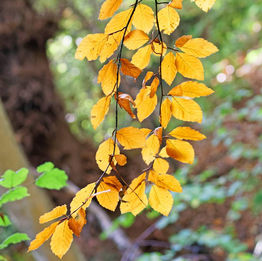top of page

Hob Hey Wood Friends Group
Autumn
This season is, of course, famous for autumn colour. Hob Hey Wood’s trees put on a beautiful display in some years. The wood’s hazel, oak, ash and birch trees turn shades of golden yellow to red. Sunlight filtering through these trees can look spectacular. The fallen leaves reflect the autumn sunlight creating a glowing carpet for us to walk on.
Perhaps the ‘best’ tree at this time is the beech. There are several beech trees in the wood and they are amazing in their autumn colours with a deep, almost glowing, bronze colour. A close second is the field maple. This is a native maple whose leaves turn an amazing orange/yellow colour in autumn; looking up through the canopy of a maple filters the sunlight and makes it glow spectacularly. A walk in the autumn sunshine can be one of the best ways to enjoy Hob Hey Wood.
Less obvious than the fabulous display put on by the trees are the wood's array of autumn fungi. Lots of species live in the wood, some live on the ground, others on trees. The range of shapes and colours is amazing. The names of some of the species are amazing, too, with puffballs, stinkhorns, poor man's beefsteak, jelly ear and candle snuff all species you might encounter.
Autumn, with it’s shorter days is my time for putting out my trail camera. This captures the antics of the resident badgers as they go about their lives during the dark hours. I love getting the camera back home to see what they’ve been up to.
It's also my last chance to get to see the wood's bats. There are several species that roost and hunt here: common, Nathusius' and soprano pipistrelles, noctule bats (our largest species with a wingspan of 40cm!), brown long-eared bat, and Daubenton's bat. I have also detected, Brand's or whiskered bats, but it is difficult to distinguish between the two. It's surprising how easy they are to see before the sky gets fully dark, silhouetted against the sky. A bat detector will show bats present even if you can't see them.
Like much of our wildlife, bats have fared badly in recent years. Ancient semi-natural woodland provides a refuge for these wonderful creatures; its biodiversity providing much food and its old trees plenty of places to roost. It's worth getting out in the wood in September and October before the bats enter their hibernation roosts.
Autumn is also the time for collecting food from the wood. Of course, the orchard, with its pear, apple damson and plum trees is the first place to stop. This fruit is free to pick and quite delicious. Apple crumble, plum crumble and damson jam are just some of the uses people put the fruit to this year. In addition, brambles abound on the woodland edges and in some years the blackberry crop can be spectacular. Bramble jam is lovely and lasts far longer than the berries on their bushes do! Hazel trees are also plentiful and a few minutes collecting can yield a handful of delicious nuts. In addition to this bounty, there are a few spots where blackcurrants grow as well as wild raspberry. What an amazing place for a fan of fruit and jams.
A Slightly less well known foraged food present in the wood is the crab apple. These are incredibly tart-tasting and unsuitable for eating raw. However, they can be made into a lovely crab-apple jelly. We'll be looking to collect some crab apples this autumn.
Rose hips can also be collected in the wood from the two rose species present: dog rose and field rose. These can be made into rosehip syrup but also rosehip tea which is apparently very refreshing.
One food I’d leave well alone is fungi. There are some edible fungi in the wood, but collecting these should be left for experts; some species can be deadly yet look similar to edible species. There is a saying amongst fungi foragers “everything is edible, at least once!”…


bottom of page









